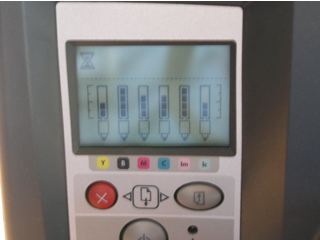Frugality is thy name.
I did some arithmetic to show just how inexpensive ink and paper are when it comes to a large exhibition print using the DJ90 here.
Well, it’s coming up on my first anniversary of ownership of the HP DesignJet 90 printer and it finally came time to replace one of the ink cartridges as the Light Magenta indicator started blinking, showing the ink was about to run out. Replacement is literally a 10 second afffair – pull the old, plug in the new.
An appropriate time to point out that the DesignJet should never be unplugged from the mains; even when switched off with the front panel push-button, the DJ keeps the ink cartridges warm to prevent clogging. The front panel light attests to the fact the printer is getting power and the warmth of the ink cartridge area confirms the clever warming feature, something sorely needed on my older Epson 1270 which would clog up if not used for a month or so. I just came back to the DJ after six weeks of not using it and the first print was as perfect as any other. Why HP doesn’t shout about this feature from the rooftops beats me, but then it’s always been a company more about engineering than marketing.
Here are the ink meters right after replacing that Light Magenta cartridge:

My best estimate is that over the past year I have made twenty 18″ x 24″ prints and fifty 13″ x 19″ ones, before that first cartridge gave up the ghost. As the picture shows, the other cartridges are between 1/2 and completely full. Do the math and that works out at less per square inch than those great instant 6″ x 4″ prints from the local drug store at 19 cents each. And you get fade resistant inks into the bargain – suffice it to say that Wilhelm’s test say 82 years or something silly, meaning I won’t care when these start fading! Wilhelm Research is the leader in testing ink longevity.
HP seems to be continuing with the dye ink based DJ series, even though the new pigment ink based DesignJet Z series with built-in colorimeters would appear to be their latest thing. The Z series uses pigment inks. Pigments rest on the surface of the paper like paint on a wall, whereas dyes need a porous medium as they are absorbed, like stain on wood, meaning that the paper you use with the DJ90 has to be suitable for dye based inks – not all papers are absorbent.
I have read tests on the Z series which suggest that there is nothing to choose between dyes and pigments (heretofore dyes were generally regarded as superior for color fidelity) though I have not seen Z prints for myself. Given the target user market for the new Z printers – professionals – I doubt that HP would supercede the DJ dye printers with something inferior. These are very costly printers and not something you would really want to use for small prints.
Anyway, after almost a year the honeymoon with the Hewlett Packard DesignJet 90 printer continues untroubled – no breakdowns, no lockups, no cryptic messages. Should these ever get remaindered and you like big prints, do consider one if you can make the space for it at home. That’s with a Mac, of course. I can’t see how any Windows user could write objectively about up time given that he or she is busy rebooting most of the time….